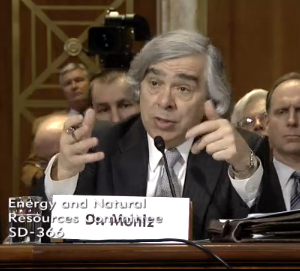Federal Water Tap, May 20: Fracking Regulations, Arctic Strategy, Infrastructure
The Bureau of Land Management’s revised regulations for hydraulic fracturing, aka fracking, on federal lands pleased almost no one outside of Congress. The proposal has three prongs: disclosure of chemicals in the fracking fluid, quality-control for well construction, and wastewater disposal. The BLM’s goal is to streamline the reporting process “without introducing unnecessary new procedures or delays,” according to the proposal.
Energy companies will be able to disclose the chemicals through FracFocus, an industry-sponsored website that a recent Harvard Law School study criticized for being too lax. Companies can wait until after a well has been fractured to report the chemicals. They can submit an affidavit claiming the chemical mix is a trade secret to avoid some reporting requirements, but the BLM does reserve the power to see the properties of any chemical proposed for exemption.
Construction standards for the cement well casings are altered slightly in the revised regulations.
As for wastewater, environmental groups wanted the BLM to require that it be stored in closed tanks but the agency will accept storage in lined pits. The BLM will continue to study the costs and benefits of a tanks-only rule.
Climate Change and Infrastructure
The Government Accountability Office, an internal watchdog, says that the federal government has important information for making infrastructure more resilient to climate change but that this information often does not reach local government officials, who generally decide what to build and where and when.
The GAO recommends that several federal agencies take steps to incorporate climate change planning into design standards and environmental reviews while improving the flow of information from the top down.
The GAO’s findings jibe with Circle of Blue’s reporting on how climate change is altering the calculus for water and sewer infrastructure.
Water Abroad
The U.S. Agency for International Development released its first strategy for water and human development. The strategy focuses on two areas: health and agriculture. Circle of Blue will have a more detailed report later this week.
Arctic Infrastructure
The Arctic is melting and the U.S. is not prepared for new maritime demands. The U.S. Army Corps of Engineers announced it will study the environmental effects of building a deep port on the Seward Peninsula in western Alaska. Such a port, along with supporting facilities, would be necessary to handle an increase in all sorts of maritime traffic.
A draft review will be published no earlier than December 2013. To comment on what should be included in the study, email michael.9.salyer@usace.army.mil, using the subject line: “NOI Comments; Environmental Impact Statement for Arctic Deep Draft Ports Navigation Improvements Feasibility Study.”
The polar region is a hot topic. A few days earlier the Obama administration released a national strategy for the Arctic. The 13-page document envisions a region “free of conflict…where economic and energy resources are developed in a sustainable manner that also respects the fragile environment and the interests and cultures of indigenous peoples.”
Great Lakes Water Quality
In the last 25 years, water quality has improved in some areas and seen significant changes in others, according to a biennial report from the commission that manages waters shared by Canada and the U.S.
The International Joint Commission looked at chemical, biological, and physical markers. Concentrations of chemicals have largely declined. Biologically, results are mixed. Dozens of non-native species have been introduced; trout populations are stable but below targets. Sturgeon, on the other hand, have started to bounce back. The two physical indicators – surface water temperature and ice cover – point to a warming trend and future management challenges.
Carbon Capture and Storage (CCS)
Two Department of Energy projects moved forward. The department confirmed that it will pay $US 167 million, half the total cost, for a facility to capture carbon from a commercial power plant southwest of Houston, Texas. The product will be used in nearby oil fields to get more carbon out of the ground.
The environmental review for a CCS project in Lake Charles, Louisiana, is available. With a proposed $US 261 million in federal assistance, the project would trap carbon emissions from a gasification plant and use them for oil production in Texas. Public comments are being accepted through June 25 and can be emailed to LeucadiaEIS@netl.doe.gov.
In other carbon news, the Energy Department gave the green light for Freeport LNG to export liquefied natural gas to countries without a U.S. free trade agreement. The company still needs approval from a different set of federal regulators to build the facility, to be located at an existing terminal in Texas.
Federal Water Tap is a weekly digest spotting trends in U.S. government water policy. To get more water news, follow Circle of Blue on Twitter and sign up for our newsletter.
Brett writes about agriculture, energy, infrastructure, and the politics and economics of water in the United States. He also writes the Federal Water Tap, Circle of Blue’s weekly digest of U.S. government water news. He is the winner of two Society of Environmental Journalists reporting awards, one of the top honors in American environmental journalism: first place for explanatory reporting for a series on septic system pollution in the United States(2016) and third place for beat reporting in a small market (2014). He received the Sierra Club’s Distinguished Service Award in 2018. Brett lives in Seattle, where he hikes the mountains and bakes pies. Contact Brett Walton






Leave a Reply
Want to join the discussion?Feel free to contribute!